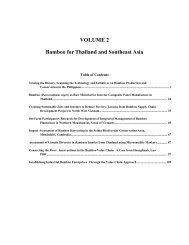WBC-VIII-Vol.4 – Resources – Forestry, Plantations and ... - BambuSC
WBC-VIII-Vol.4 – Resources – Forestry, Plantations and ... - BambuSC
WBC-VIII-Vol.4 – Resources – Forestry, Plantations and ... - BambuSC
Create successful ePaper yourself
Turn your PDF publications into a flip-book with our unique Google optimized e-Paper software.
Discussion<br />
As of the research in 1990, it was concluded that P. bambusoides forest did not finish the recovering process<br />
from flowering completely <strong>and</strong> that tree species tended to extend their territories (Yoshida et. al 1991).<br />
Nevertheless, the results of the following vegetation research in the mixed bamboo forest indicate that, in some<br />
cases, P. bambusoides does not continue to decline its territory <strong>and</strong> begins to defeat tree species again. This is<br />
clear from the decrease of the number of individuals <strong>and</strong> number of tree species during 16 years. Especially, the<br />
decline of planted trees, Cryptomeria japonica in this research site, caused by suppression of bamboo is<br />
conspicuous. Furthermore, even the evergreen broad-leaved shrub species tend to decline when they do not<br />
have enough capacity to make coppice shoots. Also the tall Ulmaceae species, which are forming forest canopy<br />
with bamboo, are presumed to decline because of the lack of succeeding seedlings <strong>and</strong> saplings, except in case<br />
with large disturbance.<br />
P. bambusoides is thought that its activity was still increasing in comparison with the condition of 1990, <strong>and</strong> that<br />
the process of recovery from flowering had been continued for 25 years after flowering. However, it is<br />
estimated that the tendency of increase of its activity is slowing down after 1995. This presumption is followed<br />
by the increase of the percentage of small new culms <strong>and</strong> by the decrease of the number of large culms.<br />
Nevertheless, it is difficult to identify the cause whether to the end of process of recovery from flowering or to<br />
the careless management condition.<br />
In this research it was indicated that the vigorousness of P. bambusoides after flowering was continued at least<br />
for 25 years. Tree species, which enlarged the territories during the recovery of bamboo, were suppressed by<br />
bamboo again. The bamboo forest vegetation is considered to need more than 25 years after bamboo flowering<br />
to stable the vegetation condition which means the coexistence of bamboo <strong>and</strong> trees. Moreover, at the stable P.<br />
bambusoides forest, it is shown that a large amount of new culms is recognized on every two or three years, <strong>and</strong><br />
on each following year new culms are comparatively small <strong>and</strong> died young.<br />
Now, in Japan, the resumption of management, like density control of bamboo culms, fertilizing <strong>and</strong> so on, is<br />
expected to set the domestic supply of materials for bamboo industry on the suitable way <strong>and</strong> to restore it in the<br />
stable condition before the flowering of P. bambusoides.<br />
Reference<br />
Kasahata, K. 1971. Flowering of bamboo. Iden, 25(8), 83-90 (in Japanese)<br />
Yoshida,H.; Sakamoto,K.; Shibata,S. 1991.L<strong>and</strong>scape change of riparian forest <strong>and</strong> its st<strong>and</strong> structure in the<br />
east-coast plain of Lake Biwa. J. Jpn. Revegetation Technology, 17(1), 37-47 (in Japanese with<br />
English abstract)<br />
<strong>VIII</strong> World Bamboo Congress Proceedings Vol 4-142




